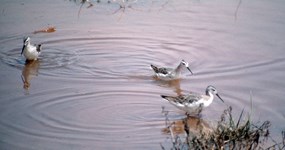
NPS Photo In this arid region, it seems odd to think about riparian habitats. Riparian areas are a very small percentage of the Arizona, but a very important part of the landscape. There is no universally accepted definition for riparian areas. There are many reasons for this, including the pact that riparian areas can be found in a dizzying array of places, from tropical forests to deserts. Even in Arizona there is great variation in riparian areas. Some riparian areas as permanent while others are intermittent or ephemeral-the latter two are the types found in the park, including Puerco River and many washes. Riparian areas are considered the most productive habitats in northern America and "ribbons of life." They provide wildlife habitats, filtration and retention of sediment, reduction of chemical inputs from uplands, stabilization and build up of stream banks, increase water storage and recharge aquifers, and reduction of floodwater runoff. Seventy percent of the threatened and endangered vertebrates in Arizona depend on riparian areas. Riparian areas are some of the most endangered habitats in Arizona, many overtaken by development and recreation. Riparian areas have been a part of human history for thousands of years. Civilization grew up along rivers, the Nile, the Tigris and Euphrates, the Indus, and the Little Colorado Rivers. The last one may not ring as loudly as some of the rivers, but this ribbon of greenery in northern Arizona was a lifeline to the ancestral Puebloans. The Puerco River that flows through the lowest section of Petrified Forest National Park was important to the farming communities such as Puerco Pueblo. The plant communities in riparian areas are defined by availability of water, types of soil, and invasive species. The most common plants found in riparian areas of the park include: Cyperus esculentus chufa flatsedge Cyperus niger black flatsedge Cyperus squarrosus bearded flatsedge Eleocharis palustris common spiderush, creeping spikerush Eleocharis parishii Parish's spikerush Schoenoplectus acutus var. acutus hardstem bulrush Schoenoplectus maritimus cosmopolitan bulrush Phragmites australis common reed Populus angustifoia narrowleaf cottonwood Populus deltoides ssp. wislizeni Fremont cottonwood Populus fremontii Fremont cottonwood Populus xacuminata [angustifolia x deltoides] lanceleaf cottonwood Salix exigua coyote willow Salix gooddingii Goodding's willow Tamarix chinensis* fivestamen tamarix, saltcedar-nasty non-native Typha domingensis Pers. southern cattail, common cattail While in Petrified Forest National Park, visitors can often see wildlife around the riparian areas, particularly by Puerco Pueblo. Many bird species can be seen in the dense vegetation, migrating water birds take a rest on their way north and south, songbirds make their homes under the fluttering leaves of the cottonwoods. Mammals or their tracks can be spotted along the waterways. In winter, elk have come down from the mountains to the bed of the Puerco. Take the time to visit a great website created by the University of Arizona (non-National Park Service and therefore may have different ideas and opinions)-Arizona's Riparian Areas. |
Last updated: February 24, 2015
